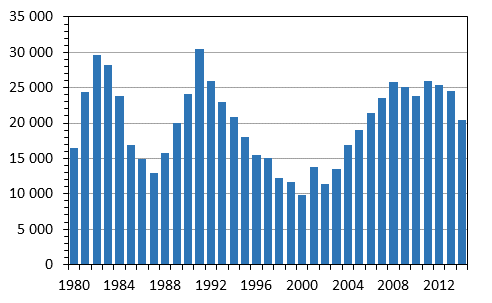Published: 27 March 2015
Finland's population was 5,471,753 at the turn of the year
According to Statistics Finland's statistics on population structure, the official total population of Finland at the end of 2014 was 5,471,753. Finland had a male population of 2,691,863 and a female population of 2,779,890. In the course of 2014, Finland’s population grew by 20,483 persons. Eighty-seven per cent of the population growth occurred in Uusimaa and 77 per cent in the Helsinki region. The growth in the size of the population was good 4,000 persons lower than one year earlier.
Change in the population in 1980 to 2014, persons

Number of persons aged 20 to 64 has already fallen for five consecutive years
The number of persons aged 20 to 64 in the population declined in 2014 for the fifth consecutive year. The number grew after the Continuation War continuously until 2005. The number of those aged 20 to 64 in Finland was at its highest at the end of 2009 at 3,218,000. At the end of 2014, the number was 3,177,000.
Population increased in eight regions
During 2014, the population grew in eight and diminished in eleven regions. In absolute numbers, the population grew most in Uusimaa, by 17,915 persons, in Pirkanmaa, by 3,216 persons, and in North Ostrobothnia, by 2,110 persons. The relative population increase was also highest in Uusimaa, 1.1 per cent. The region of Uusimaa accounted for 87 per cent of the population growth.
In absolute numbers, the population decreased most in Kymenlaakso, by 987 persons, and in Etelä-Savo, by 956 persons. In relative numbers, the population decreased most in Kainuu, by 0.9 per cent.
Fewer than one hundred municipalities increased their population
During 2014, the population grew in 96 and diminished in 221 municipalities. Helsinki had the biggest absolute increase in population, 8,051 persons, followed by Espoo, 4,790 persons, and Vantaa, 2,705 persons. The biggest absolute decreases in population occurred in Kouvola (473 persons), Jämsä (330 persons) and Savonlinna (312 persons). Apart from Kouvola, the population increased in all 15 largest municipalities measured by population.
Examined by municipality in Mainland Finland, Kauniainen (2.8 per cent), Kustavi (2.6 per cent), Lempäälä (1.9 per cent) and Espoo and Kontiolahti (1.8 per cent) had the largest relative increases in population. Examined by municipality in Mainland Finland, the largest relative decreases in population occurred in Karijoki, down by 3.6 per cent and Ylitornio and Kannonkoski, by 3.0 per cent.
Demographic dependency ratio highest in Etelä-Savo, lowest in Uusimaa
At the end of 2014, there were 896,608 persons aged under 15 in Finland and 3,483,757 persons aged between 15 and 64. Persons aged 65 or over numbered 1,091,388 at the end of 2014. The demographic dependency ratio, that is, the number of those aged 15 or under and 65 or over per 100 working age persons, was 57.1. The demographic dependency ratio was last higher than this in 1961. During our independence, the demographic dependency ratio was at its highest in 1917 (67.6) and at its lowest in 1984 (46.7).
Examined by area, the demographic dependency ratio was highest in the regions of Etelä-Savo, 67.1, and Central Ostrobothnia, 65.4. The demographic dependency ratio was lowest in the region of Uusimaa, 49.2. Examined by municipality, the demographic dependency ration was highest in Luhanka, 100.8, and Kuhmoinen, 99.2, and lowest in Helsinki, 43.4, and Tampere, 46.5.
Due to the changes made to the production system of the statistics on population structure, the PX-Web StatFin tables concerning nationality, marital status, country of birth, religion and native language will be updated on 10 April 2015.
Source: Population Structure 2014, Statistics Finland
Inquiries: Markus Rapo 029 551 3238, vaesto.tilasto@stat.fi
Director in charge: Riitta Harala
Publication in pdf-format (304.0 kB)
- Tables
-
Tables in databases
Pick the data you need into tables, view the data as graphs, or download the data for your use.
Appendix tables
- Figures
- Quality descriptions
-
- Quality description: Population structure 2014 (27.3.2015)
Updated 27.3.2015
Official Statistics of Finland (OSF):
Population structure [e-publication].
ISSN=1797-5395. 2014. Helsinki: Statistics Finland [referred: 19.4.2025].
Access method: http://stat.fi/til/vaerak/2014/vaerak_2014_2015-03-27_tie_001_en.html

